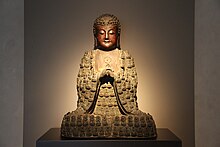Fazang
Fazang (Chinese: 法藏; pinyin: Fǎzàng; Wade–Giles: Fa-tsang; 643–712) was a Sogdian-Chinese Buddhist scholar, translator, and religious leader of the Tang dynasty.
[1][4][5] Fazang's ancestors came from the Central Asian region of Sogdia, a major center for Silk Road trade, but he was born in the Tang capital of Chang'an (now Xi'an), where his family had become culturally Chinese.
His title as a teacher and of distinction (biéhào 別號) was Dharma Master Guoyi 國一法師, in which his disciples referred to him post-ordination and in the latter stages of his life.
[8] Accounts of the affluence of Fazang's grandfather hint at his father's ability to attain higher up positions in Tang aristocratic circles, despite being a Sogdian immigrant.
Fazang also had a multitude of fellow-disciples although sources only record four primary names: Huixiao, Huaiji, Huizhao, and most famously, Uisang, who went on to establish Hwaeom Buddhism in Korea.
[12] After several years of seclusion and hearing his parents were ill, Fazang returned to Chang’an and eventually met his first teacher Zhiyan, after impressing him with his knowledge of the Avatamsaka.
[8] After 670 and Fazang's monastic ordination, he spent time traveling between Mount Zhongnan (staying at Wuzhensi and Zhixiangsi) and Taiyuansi in the capital.
[16] Between 688 and 689, Fazang was ordered by Empress Wu (at this time acting as regent) to build a high Avatamsaka-seat and bodhimanda of Eight Assemblies in Luoyang.
[23] According to Chen, it is likely that Fazang used Xuanzang's version of the Dhāraṇī of Avalokiteśvara-ekadaśamukha, an esoteric dharani (incantation) for the purpose of repelling enemies intent on attacking.
[25] During this time, Fazang is said to have gone on a quest to Famen Temple to retrieve a sacred relic that supposedly provided therapeutic relief.
[26] After Wu's retirement of the position due to political infighting, Li Xian was reinstated as emperor, and Fazang declared his loyalty to him.
[30] In the last years of his life, Fazang acquired increased imperial support, promoting the construction of new Huayan Buddhist monasteries in the two capitals (Chang’an and Luoyang), and as well as in Wu and Yue (Zhejiang and Jiangsu).
[31] Fazang died on December 16, 712 (at 69 years old) at Great Jianfu temple and was honored accordingly by Emperor Ruizong with a generous posthumous donation.
The teachings of the Avatamsaka sutra were propagated through numerous lectures as well as through his close relationship with Empress Wu and other members of the imperial household.
[8] Fazang is also credited for having contributed greatly in improving and promoting the technology of wood block carving (xylography), which he used for the printing of Buddhist texts.
[33] Along with the Indian master Divākara (Dipoheluo 地 婆訶羅 or Rizhao 日照; 613–688), Fazang also produced a translation of an extended edition of the Gaṇḍavyūha sūtra (Ru fajie pin, 入法界品, Chapter on Entering the Realm of Dharma), which makes up the last section of the Avatamsaka sutra.
[47] Fazang draws out the metaphysical implications of this Buddhist doctrine within a Mahayana framework informed by ideas like buddha-nature (which he considers to be the source of all things) and mind-only (cittamatra), often interpreted as a kind of idealism.
[9] In East Asian Buddhism, the Dharmadhatu (法界, fajie, realm of dharma) is the whole of reality, the totality of all things, the absolute.
[49] A key element of Fazang's understanding of the totality of things is a unique view of the Buddhist theory of dependent arising, which is informed by Mahayana sources like the Avatamsaka sutra.
[50][49] According to Wei Daoru, this theory holds that "countless dharmas (all phenomena in the world) are representations of the wisdom of Buddha without exception ('pure mind of the original nature', 'one-mind' or 'dharmadhatu').
"[50] The central and unique element of this view of dependent arising is the "interpenetration" (xiangru) of all phenomena (dharmas) and their "perfect interfusion" (yuanrong, 圓融).
[51] Alan Fox similarly describes the doctrine of interpenetration as the fact that all possible particular events "overlap and coexist simultaneously and at all times, without conflict or obstruction.
[51] Fazang was known for the various similes, demonstrations and metaphors he used to explain this idea, including Indra's net, the rafter and the building, and the hall of mirrors.
[53] The six characteristics are:[38][51] According to Wei Daoru, Fazang's schema is supposed to illustrate how all things are in a state of mutual correspondence and interfusion, and how all phenomena are completely non-dual.
Because the boundless principle (or, the gold) always remains empty and lacks a permanent nature (zixing), it can be transformed into many relative forms (like the various shapes that make up the lion statue).
[57][7] According to Fazang's commentary on Mahayana Awakening of Faith, all phenomena (dharmas) arise from a single ultimate source, the "nature" or "One Mind".
[51] Furthermore, drawing on the Buddha-nature treatise, Fazang writes that there are three kinds of nature and origination: principle, practice and fruit (li xing guo).
[51] Fazang, and the Huayan tradition as a whole, venerate a particular understanding of the universe as being the very body of the supreme cosmic Buddha Vairocana (whose name means "The Illuminator").
Weiyu Lin sees Fazang's conception of Vairocana, which is "omnipresent, omnipotent and identical to the universe itself", as containing elements which resemble some forms of theism.
"[70] According to Imre Hamar, Fazang was the first to argue that "enlightenment at the stage of faith" (xinman cheng fo 信滿成佛) was "a unique doctrine of the distinct teaching of One Vehicle".







